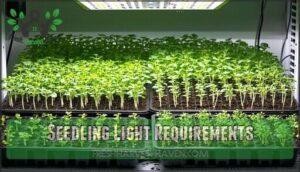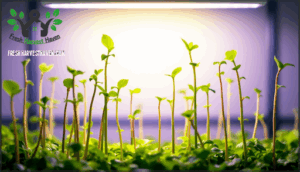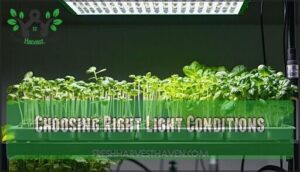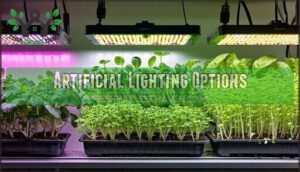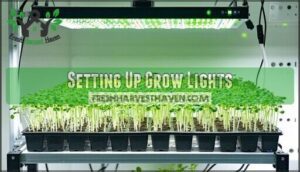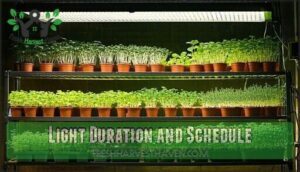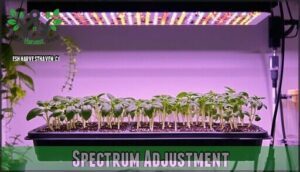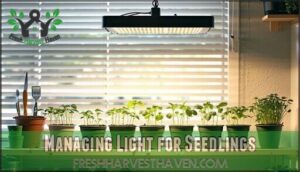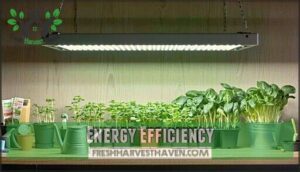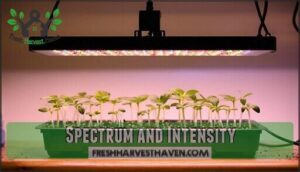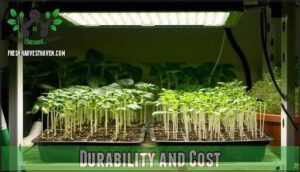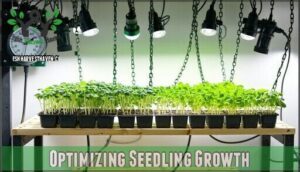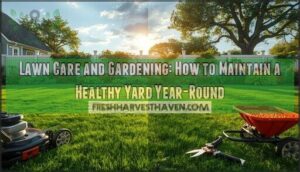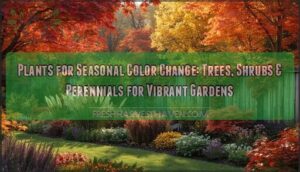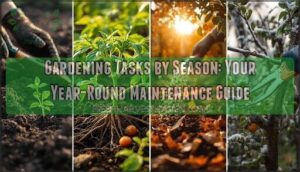This site is supported by our readers. We may earn a commission, at no cost to you, if you purchase through links.
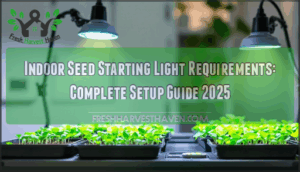
Without adequate lighting, they’ll stretch toward any available light source, becoming weak and spindly—a condition called "legginess" that’s tough to reverse.
You’ll want to position grow lights 6-12 inches above your seedlings, depending on the light type and intensity.
LED grow lights offer the best energy efficiency and heat control, while fluorescent lights work well for budget-conscious gardeners.
The key is consistency—use timers to maintain your lighting schedule automatically.
Getting your indoor seed starting light requirements right from day one sets the foundation for robust transplants that’ll dominate your garden later.
Table Of Contents
- Key Takeaways
- Seedling Light Requirements
- Effects of Insufficient Light
- Choosing Right Light Conditions
- Artificial Lighting Options
- Setting Up Grow Lights
- Managing Light for Seedlings
- Selecting Best Grow Lights
- Optimizing Seedling Growth
- Frequently Asked Questions (FAQs)
- What kind of light do I need to start seeds indoors?
- When starting seeds indoors, do they need sunlight?
- Is it better to germinate seeds in the dark or in the light?
- How much light is needed for seed germination?
- Can grow lights replace natural sunlight completely?
- How much electricity do grow lights consume?
- What causes seedlings to stop growing suddenly?
- Do different seed types need different lights?
- When should I transplant seedlings outdoors?
- Can seedlings survive with just window light?
- Conclusion
Key Takeaways
- You’ll need to provide 14-16 hours of bright light daily to prevent weak, leggy seedlings that stretch toward inadequate light sources
- Position your grow lights 6-12 inches above seedlings and use timers for consistency—LED lights offer the best energy efficiency and heat control for this setup
- Without proper lighting intensity, you’ll get pale, yellowing leaves and stunted growth that produces inferior plants with fewer flowers or vegetables
- Choose full-spectrum LED or fluorescent lights (5000K-6500K) and monitor your seedlings daily to adjust light distance and prevent burning or stretching
Seedling Light Requirements
Your seedlings need 12-18 hours of daily light exposure to develop strong stems and healthy foliage.
Strong seedlings thrive with consistent daily light—no shortcuts to healthy growth.
Understanding the specific light intensity requirements and spectrum needs for your plants will determine whether you choose fluorescent, LED, or other artificial lighting systems.
Daily Light Hours
The ideal light duration for indoor seed starting ranges from 14-16 hours daily, creating photoperiods that maximize seedling vigor and photosynthetically active radiation (PAR) absorption.
This light cycle mimics natural circadian rhythms while providing sufficient Daily Light Integral (DLI) for robust development.
Most vegetables and flowers thrive within this range, though you’ll want to check your specific seed packets for any variations.
The key is consistency – your seedlings need predictable light cycles to develop strong stems and healthy foliage.
Essential light duration guidelines include:
- 14-16 hours of daily illumination for ideal photosynthesis and growth
- 8-10 hours of darkness for metabolic processes and hormone regulation
- Timer-controlled consistency to prevent stress and irregular growth patterns
Remember, your seedlings aren’t marathon runners – they need rest periods just like athletes.
Too few hours create leggy, weak stems reaching desperately for light, while excessive illumination wastes energy without meaningful growth benefits for your indoor seed starting setup.
Understanding proper growth conditions is vital for a successful harvest.
Light Intensity Needs
When measuring light intensity for seedlings, you need to understand the science behind photon delivery.
Lux Levels between 25,000-35,000 provide adequate Light Metrics for healthy development.
PPFD Explained: this measures actual photosynthetic energy reaching plants at 100-300 micromoles per square meter per second.
Photon Density determines growth quality—insufficient Intensity Measures create weak, stretchy seedlings.
Position LED grow lights 6-12 inches above seedlings, adjusting based on light intensity readings.
Spectral Balance affects these measurements, but proper seedling light needs focus on consistent photon delivery.
Monitor light requirements with smartphone apps for successful indoor seed starting.
Spectrum Requirements
Getting your light spectrum right can make or break your seedling success. You need to understand how different light wavelengths affect plant development to photosynthesize effectively.
Blue light (400-500nm) keeps stems compact and sturdy, while red spectrum (600-700nm) supports root development. Full spectrum LED grow lights with color temperatures between 5000-6500K deliver the perfect balance your seedlings crave.
Here’s what you need for ideal grow light spectrum:
- Blue wavelengths – Prevent stretching and create stronger stems
- Red wavelengths – Boost root growth and prepare for flowering
- Fullspectrum coverage – Mimics natural sunlight for complete development
- Proper PAR values – Guarantees photosynthetically active radiation reaches plants
Your light spectrum choice directly impacts seedling quality, so don’t skimp on this vital element.
Effects of Insufficient Light
Without enough light, your seedlings will stretch upward desperately searching for more illumination, creating weak and spindly stems that can barely support their own weight.
Deprived seedlings become desperate light-seekers, stretching into fragile failures.
You’ll notice pale, yellowing leaves and stunted** growth that ultimately produces inferior plants with fewer flowers or vegetables.
Leggy Seedlings
When your seedlings don’t get enough light, they’ll stretch upward like they’re reaching for the sun—creating leggy growth that weakens your plants.
This seedling stretch happens because inadequate light intensity triggers survival instincts, causing weak stems that can’t support healthy seedling growth.
Poor light distance and overcrowded seedling support systems make the problem worse.
These leggy seedlings develop fragile stems that break easily, compromising your entire indoor seed starting project.
Without proper seedling light requirements, even strong varieties will develop stem strength issues that lead to disappointing harvests.
Leaf Color Changes
Poor light intensity triggers visible distress signals in your seedlings’ foliage. Chlorophyll levels plummet when photosynthesis rates slow, causing dramatic color shifts from healthy green to pale yellow or white.
These changes aren’t nutrient deficiency symptoms—they’re your plants desperately signaling inadequate light spectrum exposure.
Watch for these progression stages:
- Pale green leaves – Early warning of declining chlorophyll production
- Yellow coloration – Advanced stage showing compromised photosynthesis
- White patches – Severe breakdown of leaf pigments
- Gradual worsening – Color changes intensify without proper light intensity correction
Unlike leaf burn from excessive exposure, this fading develops slowly as seedlings struggle with insufficient lighting conditions.
Reduced Growth Rates
Without adequate light, your indoor seed starting operation hits a wall.
Stunted growth becomes the norm as inadequate photosynthesis starves plants of energy they need.
You’ll notice slow development across the board – weak stems that can’t support themselves, poor nutrition uptake, and leggy seedlings reaching desperately for more light.
Even top-tier LED grow lights won’t help if light intensity stays too low for proper seedling growth.
Choosing Right Light Conditions
Not all seedlings need the same amount of light to thrive, and understanding these differences will save you from overwatering your tomatoes while your lettuce stretches toward the ceiling.
You’ll need to match your lighting setup to whether you’re growing low, medium, or high light plants for the best germination and early growth results.
Low Light Plants
Low light plants exhibit remarkable shade tolerance, thriving where most seedlings would fail. However, don’t mistake these hardy survivors for suitable candidates during indoor seed starting.
Even shade-adapted varieties need adequate illumination for healthy germination and early development. Once established, these plants flourish under LED grow lights set to minimal intensity.
Top performers for challenging indoor gardening conditions:
- Snake plants – Virtually indestructible champions that forgive neglect
- Pothos – Rapid growers that adapt to any corner you choose
- ZZ plants – Water-storing powerhouses built for dark spaces
- Chinese evergreens – Colorful companions that brighten dim rooms
- Peace lilies – Dramatic beauties that signal their watering needs
These plant adaptation experts require well-draining soil and less frequent watering since dark germination slows moisture evaporation, preventing common overwatering issues.
Medium Light Plants
Medium Lighting conditions offer the perfect balance for Plant Care enthusiasts starting their Indoor Gardens.
These medium light plants thrive with 150-250 μmol m-2s-1, making them ideal for indoor seed starting projects.
Popular choices like rubber plants, spider plants, and monstera adapt well to office environments with standard fluorescent lighting.
LED grow lights with Balanced Spectrum output perfectly supplement natural light, ensuring ideal Seedling Growth.
Your seed starting lights should provide consistent illumination without overwhelming these adaptable plants.
Light requirements for medium varieties remain manageable, allowing steady progress without constant adjustment of your lighting setup.
High Light Plants
High light plants thrive under intense illumination, demanding 250-450 umol m-2s-1 for vigorous seed starting success. These light-hungry varieties won’t settle for anything less than premium LED grow lights or south-facing windows that deliver serious photon power.
Your seed starting lights need to pack a punch for these demanding seedlings. Think of it like feeding athletes—they need more fuel than weekend warriors. Most high-light varieties require 14-16 hours daily under quality indoor gardening lights to develop properly.
Here’s your lineup of light-craving champions:
- Tropical Plants – Including tomatoes, peppers, and basil that demand maximum Daily Light Integral DLI for essential oil production and sturdy stems
- Desert Cacti – Require intense greens development under plant grow lights to prevent etiolation and maintain compact growth
- Bright Flowers – Sunny herbs like Mediterranean varieties need premium illumination for proper flowering and vigorous development
Without adequate light intensity, these powerhouse plants become leggy disappointments that’ll struggle outdoors. Understanding sun loving plants is vital for optimizing their growth and development in various environments.
Artificial Lighting Options
When you’re starting seeds indoors, you’ll need to choose between three main artificial lighting options: LED grow lights, fluorescent lights, and HID lighting systems.
Each type offers different benefits for your seedlings, from energy efficiency to light spectrum control.
LED Grow Lights
LED grow lights deliver unmatched spectrum control and energy savings for seed starting requirements. You’ll cut electricity costs by 50-70% while achieving superior plant response through precise LED benefits.
Lifespan Comparison
Heat Dissipation
Installation Costs
LED grow lights provide full-spectrum output engineered for indoor seedlings lights, supporting healthy development from germination through transplant. Their minimal heat emission allows positioning close to delicate seedlings without burning leaves.
LED indoor grow systems offer adjustable intensity and built-in timers, making light cycle management simple. Premium seedling grow lights deliver 3.1 µmol/J efficiency or higher, ensuring your investment pays dividends in stronger, healthier plants ready for outdoor success.
Understanding the ideal light spectrum is essential for optimizing plant growth and development.
Fluorescent Lights
While LEDs offer impressive efficiency, fluorescent lights remain the backbone of many successful seed starting operations.
These reliable indoor plant lights deliver consistent results without breaking the bank, making them perfect for beginners testing the waters.
You’ll want to position your light fixtures 2-3 inches above seedlings and run them for 16 hours daily to meet seed starting requirements.
T5 tubes pack more punch than their T8 counterparts, but both fluorescent types excel at providing the broad spectrum control your young plants crave.
Here’s what makes fluorescent seedling light sources so appealing:
- Affordable startup costs – Get growing without emptying your wallet
- Proven tube efficiency – Decades of reliable performance in greenhouses
- Gentle heat output – No risk of cooking your precious seedlings
- Wide spectrum coverage – Mimics natural sunlight effectively
- Energy savings potential – Lower operating costs than older technologies
The secret lies in combining cool and warm tubes within the same fixture to achieve light spectrum mimicry.
This approach gives you professional-grade results at a fraction of specialty grow light costs.
For ideal growth, understanding grow light options is essential to create the right environment for your seedlings.
HID Lighting Systems
Professional growers’ HID systems deliver unmatched intensity for serious seed starting operations.
These high-pressure sodium and metal halide units require ballast systems to regulate power and prevent equipment damage.
HID Benefits include deep light penetration and superior lamp efficiency compared to basic fluorescents.
Position these powerful grow lights for indoor use 24-36 inches from seedlings to prevent burning.
Lighting controls help manage heat output—you’ll need proper ventilation for larger wattage units.
While LED grow lights dominate home use, HID lights remain king for commercial seed starting lights.
Setting Up Grow Lights
Setting up grow lights correctly transforms weak, stretching seedlings into robust plants ready for transplanting.
You’ll need to master three key elements: proper distance and timing, ideal light schedules, and spectrum adjustments that match your seedlings’ growth stages, including ideal light schedules.
Distance and Angle
Perfect light placement transforms weak seedlings into robust plants ready for transplanting.
Position fluorescent lights 3-4 inches above seedlings, while LEDs need 6-12 inches for maximum seedling light exposure.
Angle adjustment guarantees even coverage—tilt fixtures slightly to eliminate shadows.
Distance control matters: too close burns leaves, too far creates leggy growth.
Add reflective surfaces around your setup to maximize efficiency and practice proper shade management for uniform development.
Light Duration and Schedule
For ideal seedling development, maintain light cycles of 14-16 daily hours followed by 8-10 hours of darkness. This photoperiod mimics natural rhythms that seedlings need for healthy growth. Light timing consistency prevents stress from irregular schedules.
- Set light scheduling timers to automate your light duration cycles
- Monitor seedling light exposure for signs of stretching or burning
- Adjust light adjustment based on plant response and growth stage
- Verify dark periods remain uninterrupted for proper metabolic functions
Understanding proper light spectrum is vital for seedling development and overall plant health.
Spectrum Adjustment
After setting your timing schedule, you’ll need to fine-tune your light spectrum for ideal seedling development. Most seedlings perform best with a Red/Blue Ratio of 60% blue to 40% red light, promoting compact growth while preventing stretching.
Spectrum Control lets you adjust Color Temperature and Wavelength Adjustment to match your plants’ needs. Blue Light Waves (400-500nm) encourage sturdy stems, while red wavelengths (600-700nm) boost root development.
| Light Type | Color Temperature | Best For |
|---|---|---|
| Cool White | 5000-6500K | Vegetative growth |
| Warm White | 2700-3000K | Root development |
| Full Spectrum | 3000-5000K | Balanced growth |
LED lights with spectrum adjustment capabilities give you complete control over Photoperiod Adjustment and seedling light spectrum optimization for stronger transplants.
Managing Light for Seedlings
When you manage light for seedlings, you’ll need to balance light and dark periods, monitor growth, and adjust intensity as needed.
Think of it as babysitting—except these babies need photons instead of bedtime stories.
Balancing Light and Dark
Your seedlings operate like night-shift workers—they need proper rest periods to thrive. Light cycles with 14-16 hours of illumination followed by 8-10 hours of dark periods prevent seedling stress and maintain healthy photosynthesis rates.
Understanding light and plant growth requires recognizing that continuous lighting disrupts natural growth patterns.
- Seedling lighting needs include mandatory darkness for metabolic recovery
- Light-dependent germination stops after sprouting, requiring photoperiod balance
- Seedling light duration beyond 18 hours causes physiological damage
- Indoor seedling care mimics natural day-night cycles for ideal development
- Darkness enables root growth and nutrient processing that daylight inhibits
Monitoring Seedling Growth
A microscope reveals details invisible to the naked eye—similarly, seedling health requires careful daily observation to catch problems early and guarantee proper seedling development stages.
You’ll notice strong stem strength when seedlings resist bending, while vibrant green leaves indicate healthy leaf development under your indoor seed starting setup.
Monitor these five critical indicators of seedling growth:
- Stem thickness – healthy seedlings won’t bend easily when touched
- Leaf color – vibrant green indicates proper seedling lighting needs are met
- Node spacing – close intervals prevent leggy growth patterns
- Root formation – white roots through drainage holes show progress
- Overall posture – upright growth demonstrates adequate light intensity measurement.
Track growth rates daily, noting changes in height and leaf emergence patterns for consistent seedling development stages.
Adjusting Light Intensity
Once you’ve observed your seedlings’ behavior, light intensity fine-tuning becomes your next priority.
LED lights with dimming capabilities offer precise intensity control, while adjustable light source positioning provides immediate spectrum tuning options.
| Distance | Light Type | Intensity Level |
|---|---|---|
| 6-8 inches | LED panels | High output |
| 8-12 inches | Fluorescent | Medium output |
| 12-18 inches | HID systems | Low-medium output |
| 2-4 inches | Compact LED | Variable output |
Your grow light setup requires constant photon management – too close burns leaves, too far creates stretching.
Light adjustment through height changes remains your primary tool for seed starting success.
Selecting Best Grow Lights
You’ll need to balance energy efficiency, light spectrum, and cost when selecting grow lights for your seedlings.
Modern LED systems offer the best combination of customizable spectrum control and long-term durability, while fluorescent options provide reliable performance at lower upfront costs.
Energy Efficiency
When choosing the right indoor grow light for your seedlings, LED options deliver unmatched energy efficiency that translates to real savings.
These energy-efficient lighting systems consume 50-70% less power than traditional fluorescent or HID alternatives, substantially reducing your power consumption and monthly bills. LED Lifespan extends 50,000-100,000 hours compared to fluorescents’ 10,000 hours, making them incredibly cost efficient long-term investments.
Fluorescent Costs pile up through higher energy usage and frequent replacements. HID Consumption can double your electricity expenses versus efficient LED alternatives.
Modern led grow lights offer exceptional light efficiency while maintaining eco friendly operation through reduced heat output and lower carbon footprint. This superior energy efficiency makes LEDs the smartest choice for your sustainable growing setup.
Understanding led grow options is vital for optimizing your indoor seed starting configuration.
Spectrum and Intensity
The perfect spectrum and intensity combination transforms weak seedlings into robust transplants ready for outdoor success.
Getting these Light Waves right means understanding how Color Temperature and Photon Density work together for maximum growth.
- Color Temperature: Choose 5000K-6500K LED lights for balanced spectrum that promotes compact, sturdy stems
- Photosynthetically Active Radiation PAR: Target 200-400 μmol/m²/s for most seedling varieties to guarantee proper photon delivery
- Wavelength Control: Full-spectrum LEDs provide essential blue and red wavelengths that chlorophyll absorbs most efficiently
- Intensity Levels: Position fixtures 6-12 inches above seedlings, adjusting distance as plants grow taller
- Spectrum Consistency: Maintain steady wavelength output throughout the entire growing period for uniform development
Proper seedling light intensity prevents stretching while adequate spectrum guarantees healthy photosynthesis rates.
Durability and Cost
Beyond spectrum and intensity, your Cost Efficiency depends on Light Longevity and Fixture Costs.
LED Durability means 50,000-100,000 hours versus fluorescent’s 10,000-20,000 hours.
While LED grow lights require higher upfront investment, they deliver substantial Energy Savings through energyefficient lighting.
Your light cost drops substantially with LEDs—they’ll outlast 3-5 fluorescent replacements.
Smart seed starting lights pay for themselves within two years through reduced electricity bills and maintenance.
Understanding winter gardening basics is vital for optimizing grow light usage and plant growth.
Optimizing Seedling Growth
Once you’ve set up your grow lights correctly, you’ll need to balance three critical factors to maximize seedling health and growth rates.
Proper light management works hand-in-hand with temperature control and watering schedules to create the ideal growing environment that transforms weak seedlings into robust transplants, which is crucial for growth rates.
Providing Adequate Light
Success hinges on light spectrum and proper grow light distance.
Position LED grow lights 6-12 inches above seedlings, providing full spectrum illumination for 14-16 hours daily.
Your seedling lighting setup shouldn’t include 24-hour exposure, which weakens plants.
Monitor seedling growth under LED options, adjusting distance when you notice stretching or pale leaves.
These seed starting tips and indoor gardening tips guarantee robust development.
Maintaining Optimal Temperature
Temperature control creates the foundation for successful seedling development. Your seeds need consistent soil temperature between 65-75°F for ideal germination. A seedling heat mat provides reliable bottom heat, working with your grow lights to maintain proper thermal control.
Heat management becomes vital when lights generate excess warmth in your indoor gardening space.
- Monitor soil temperatures with digital thermometers to prevent overheating
- Position heat mats under seed trays for consistent bottom warmth
- Make certain proper air circulation to prevent hot spots and maintain humidity
- Adjust climate regulation settings based on your specific growing environment
Ensuring Proper Watering
Your seedling’s watering routine becomes even more critical under artificial lighting conditions.
Check soil moisture daily using the finger test—insert your finger one inch deep to assess seedling moisture levels. Water when the surface feels dry but remains slightly moist underneath.
Watering Frequency Signs to Watch
Use room-temperature water and make certain proper drainage systems prevent waterlogged conditions that compromise seedling health during indoor gardening.
Frequently Asked Questions (FAQs)
What kind of light do I need to start seeds indoors?
Like the sun’s first rays awakening plants, you’ll need full-spectrum LED or fluorescent lights (5000K-6500K) positioned 2-4 inches above seedlings for 14-16 hours daily.
When starting seeds indoors, do they need sunlight?
Seeds don’t need natural sunlight to germinate – most actually prefer darkness.
However, once they sprout, you’ll need bright artificial light since window light typically isn’t strong enough for healthy seedling development.
Is it better to germinate seeds in the dark or in the light?
Ever wondered why nature keeps most seeds buried in soil’s darkness?
Most seeds actually germinate better in dark conditions, as light can inhibit the germination process for many species.
Making darkness the preferred starting point.
How much light is needed for seed germination?
Most seeds don’t need light to germinate—they actually prefer darkness.
You’ll want to keep them in dark conditions until they sprout, then immediately provide 12-18 hours of artificial light daily.
Can grow lights replace natural sunlight completely?
You can’t completely replace natural sunlight with grow lights, but modern full-spectrum LEDs come remarkably close.
They’ll provide the essential red and blue wavelengths your seedlings need for photosynthesis and healthy development.
How much electricity do grow lights consume?
A typical LED grow light system consuming 30-50 watts can add $15-25 to your monthly electric bill when running 14-16 hours daily for seedlings.
What causes seedlings to stop growing suddenly?
Your seedlings likely stopped growing due to insufficient light, overwatering, cold temperatures, nutrient deficiency, or root damage.
Check that you’re providing adequate light intensity, proper drainage, and consistent warmth for healthy development.
Ensure you’re addressing the potential issues, such as insufficient light, to promote growth.
Do different seed types need different lights?
Here’s the truth: most seedlings thrive under the same basic light spectrum, but there’s a catch.
While standard full-spectrum fluorescent or LED lights work for nearly all vegetables and herbs, flowering plants need specific red wavelengths to bloom properly indoors.
When should I transplant seedlings outdoors?
You’ll transplant seedlings outdoors after they’ve developed their second set of true leaves and completed a week-long hardening off process to gradually acclimate them to outdoor conditions.
Can seedlings survive with just window light?
Ironically, that bright south-facing window won’t cut it for robust seedling growth.
You’ll get leggy, weak stems that stretch toward inadequate light.
Window light lacks intensity and proper spectrum needed for healthy development.
Conclusion
Getting your indoor seed starting light requirements right transforms weak seedlings into garden champions.
You’ve learned to provide 14-16 hours of bright light daily, position lights 6-12 inches above plants, and use timers for consistency.
Whether you choose energy-efficient LEDs or budget-friendly fluorescents, proper lighting prevents leggy growth and guarantees robust transplants.
Monitor your seedlings closely, adjust light intensity as needed, and maintain ideal conditions for maximum success in your garden.
- https://www.reddit.com/r/vegetablegardening/comments/yaarug/how_long_should_i_keep_a_grow_light_on_seedlings/
- https://www.youtube.com/watch?v=1PEmMWxjMhY
- https://www.gardenary.com/blog/the-best-grow-lights-for-seed-starting-indoors
- https://www.johnson.k-state.edu/programs/lawn-garden/agent-articles-fact-sheets-and-more/agent-articles/vegetables/lighting_options_for_Seeds.html
- https://www.mars-hydro.com/info/post/the-ultimate-guide-to-spectrum-science-in-led-grow-lights

